

Prior Episodes | 7974 (3 BBY) | Next Episodes
Continuity & Analysis
Star Wars: Rebels - The Protector of Concord Dawn (2016) [S2E13]
Looking to secure a new hyperspace route to Lothal, the rebels head to
the Mandalorian-controlled Concord Dawn to negotiate safe passage for their fleet.
The warrior Protectors of the system prove to be less than welcoming, however,
and it's up to Kanan and Sabine to turn this group into friends... or enemies.
Star Wars: Rebels - Legends of the Lasat (2016) [S2E14]
Thanks to intel from the space pirate Hondo, the Ghost crew rescue two Lasat from
Imperial clutches. These survivors believe Zeb is the key to a prophecy that will lead
to a new home for their kind - but Zeb, conflicted and ashamed of his failure to save
Lasan, has little faith.
Star Wars: Rebels - The Call (2016) [S2E15]
Low on fuel and power in deep space, the Ghost crew encounters massive,
mysterious creatures whose lives are threatened by a mining operation.


CONTINUITY
These three standalone episodes are all about hyperspace travel. The third moon of Concord Dawn and an unidentified asteroid field
are seen for the first time, as are the planets Concord Dawn and Lira San, but only from space. Five worlds are seen in these episodes:
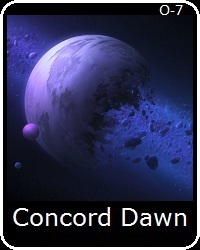

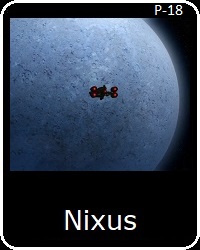


These episodes take place throughout the middle of 7974 (3 BBY). Some time has passed since 'A Princess on Lothal' (S2E12), probably a month
or more. By the time of 'The Call', it is almost certainly the second half of this calendar year, as these events are spaced out in differing
increments by weeks or even months. Ezra has now been Kanan's apprentice for more than a year and a half.
- Empire's military activity in the Outer Rim has noticeably increased in response to the rise in rebel activity and small rebel fleets.
The Spectre's last supply run was nearly compromised by increased Imperial security.

Commander Sato declares, "we need a new hyperspace route in and out of the Lothal sector", to which Sabine replies,
"I may have a perfect shortcut. The system of Concord Dawn." This was not an issue at the time this episode was written,
as all that was known was that Lothal was in the Outer Rim, and Concord Dawn had been long established as lying in
Mandalorian space on that region's boundary with the Mid Rim. These statements led many to assume that the Lothal
Sector was located somewhere nearby, or at least in the relative area near the Perlemian Trade Route. Disney-Lucasfilm
has since released supplementary material placing the Lothal Sector in grid square U-7, making it a subsector of
the Dominus Sector. This makes Sato's statement impossible to stretch. If his statement were less specific there might
have been some possibility of explaining this, however it doesn't really make any sense. Concord Dawn is in fact closer
to Coruscant in the galactic Core than it is to the Lothal Sector. What difference would a route through this space
make to the rebels' ability to move "in and out of" the Lothal Sector? This is why the location of worlds needs to be
decided behind the scenes before the material is finished, and not figured out later by out of context supplements.
Main Article: Hyperspace Travel
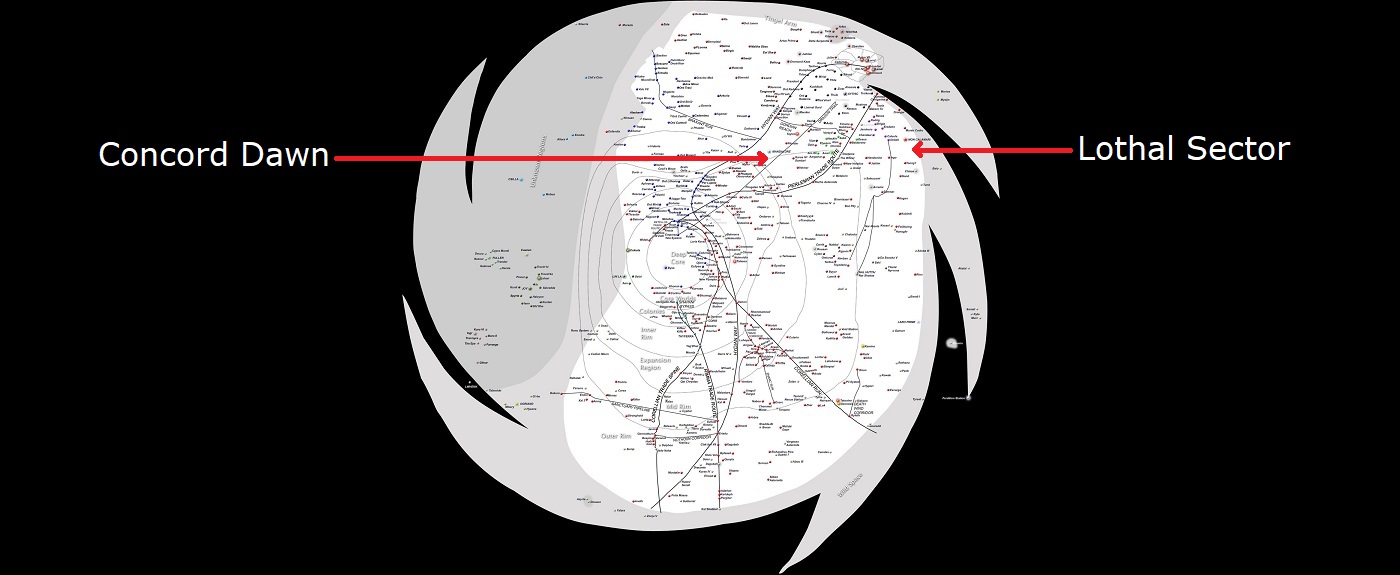
- Concord Dawn is known for its elite warriors, the Protectors, said in later episodes to recruit quality soldiers from all the different Mandalorian
clans. They were "brought in to train clones back in the war", and also fought in battles during the Clone Wars. This group predates the last
two Mandalorian civil wars, as they were fighting for the Republic during the last one, and are described also as having participated in
the previous civil war in 7935 (42 BBY), 39 years earlier, which is when Obi-Wan met Satine Kryze according to The Clone Wars.
Satine and Almec's statements in that series' episode 'The Mandalore Plot' (S2E12) regarding recent Mandalorian history seemed
very hard to believe, to the point of disrupting the narrative in that episode. This new information about the Protectors and other
examples of Mandalorians living outside of the Mandalore system make many of those statements impossible to reconcile.
Technically, this non-Lucas material should not take precedence, however that episode's backstory was not always well-thought-out.
- Concord Dawn is a Mandalorian planet located in the Mandalore Sector, in the Trans-Hydian region of the Outer Rim. Its location is so close to
the boundary of the Mid Rim that supplementary had usually located it in the Thusa Sector of that region, however material produced
in the last decade or so has increasingly emphasized its Outer Rim position. Concord Dawn is fractured, with a large chunk of one
hemisphere having been pulverized into small fragments which litter the space in near orbit. The planet has at least two moons, and
according to supplementary material has at least three. This system has been a Mandalorian planet for thousands of years, since it
has "endured more than a hundred wars." Mandalorian wars happen quite frequently, especially in antiquity, however the implication
seems to be that like Mandalore, the planet may have formerly been much more hospitable. There are unlikely to be any inhabitants on
the planet, and despite the visual evidence to the contrary, the Protector's camp is supposedly located on the third moon, not the planet.


Concord Dawn has undergone some kind of cataclysm which has left it fragmented. As it seems to have no magma
core and to be geologically lifeless, the planet is not slowly reforming into a sphere. This is possible, however it means
that the planet has been essentially rendered uninhabitable, with a highly irregular atmosphere and strange gravity,
and likely extremely unfriendly surface temperatures. The episode makes no mention of the base being on one of
the moons, and Kanan lands the ship on a world which looks very much like the primary planet in the orbital approach.
Supplementary material insists the base is on the third moon of the planet, probably because it was pointed out that
the planet would be uninhabitable. Adopting that valuable retcon gets around that issue, however the fragments of
Concord Dawn are also strewn about in a manner which makes little to no sense, no matter how the planet was
damaged. Hera remarks, "sure looks like it's been through a war", to which Sabine replies, "this system has endured
more than a hundred wars." She does not actual imply that this specific mega-scale damage was the result of warfare,
however she does not rule it out. This unlikely arrangement of fragment pieces would be slightly more plausible if
it were the result of technology and sentient life, but it would still be quite a trick to explain. This is all explored quite
thoroughly in the article linked at the end of this page in 'Further Analysis'. The author of that article also made
the understandable deduction that the base was supposed to be on the surface of the fractured planet.
Main Article: Planetology
- Ships which are damaged, even severely, but which still have a working reactor, hyperdrive, and navicomputer successfully complete
their trip in hyperspace and to normal space, even if they are no longer being crewed.
Main Article: Hyperspace Travel
- Sabine tells Kanan, "You must be pretty distracted not to have noticed I stowed away." This instance at least makes sense, however the actual
ability of Jedi to sense the presence of others various to a rediculous degree depending on what the writers decide is needed for their
story. Someone Kanan knows as well as Sabine should be very difficult to miss in the Force hiding in the same craft.
- The third moon of Concord Dawn is a habitable world with a native or transplanted ecosystem consisting mostly of tree-like plants. This
world seen in this episode and a later episode, is never identified here as a moon, rather very much appeared to be Concord Dawn
itself in the episode. That is not concrete however, and as discussed above it actually makes more sense as the primary planet in
this system is essentially uninhabitable. The large magenta-hued moon of Concord Dawn is clearly visible in the sky on this world,
however that may also be true sometimes on one of the other moons, so that is also not conclusive. This moon does not appear
to have a large population, however material from The Clone Wars suggests there is probably some settlement on this
moon besides this one Mandalorian base. It is also possible that has changed since the time of the Republic. The moon has
significant water resources, including an active water cycle with bodies of water, precipitation, and cloud cover.
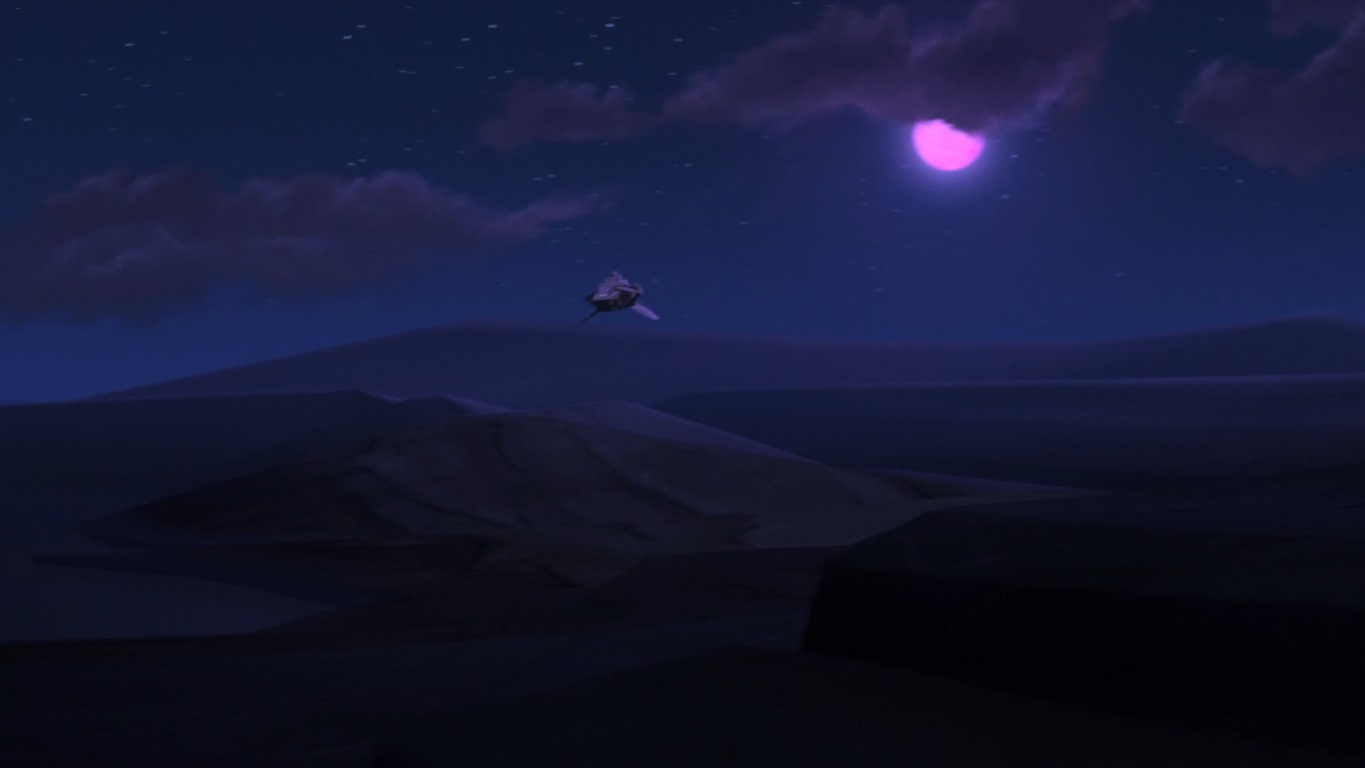
- When Fenn Rau was "younger and more reckless", he was a fighter pilot instructor for the Grand Army of the Republic. He also served at
the Battle of Mygeeto, where he and his Skull Squadron flew into the Separatist fire over and over to cover Master Depa Billaba and
Padawan Caleb Dume, who were pinned down and trapped by droids. Caleb, who is now called Kanan, claims Rau saved their lives.
These events probably took place in 7958 (19 BBY), in the last stages of the nearly three-year-long Battle of Mygeeto, what is also
sometimes called the 'Third Battle of Mygeeto', despite the fact that armed conflict never really ceased at any point. Billaba and
Dume were primarily campaigning in the New Territories region of the Outer Rim, in the galactic north, during the last months of
the Clone Wars, including the conflict on Mygeeto and the relatively nearby world of Kaller.
- Traditional Mandalorian families pass down their armor after their death to be inherited by a member of a younger generation. The armor
is usually reforged to better fit the new owner. Sabine Wren is from Clan Wren, which is part of House Vizsla. Her mother is
revealed here to have been part of Death Watch, something later implied by her appearances in The Clone Wars Season 7.
The Protectors consider Death Watch to have been traitors, which is logical considering they were Republic allies, and much more
likely to have been pro-Satine and later pro-Bo-Katan. Ursa Wren sided with Bo-Katan during the schism in Death Watch.
- Hondo arranges to sell Lasat prisoners to the Empire, and the meeting takes place on Nixus. This take place at Nixus Station 218, the same
station seen in 'Brothers of the Broken Horn' (S2E6). Hondo was also involved in that adventure, so perhaps he has decided that it makes
a easy enough place to escape from. It is most likely that Hondo chose this location because this episode's creators wanted to save
time and expense, and simply reused a previously animated station instead of one of the hundreds of other stations on the planet.
- Lasats seem to be considered enemies of the state. This is not specifically stated, however the Empire was eager to acquire two of the only
known remaining Lasats, even though they are non-threatening. The Lieutenant taking charge of them says they will be taken to
"a detention facility for a nice, long stay." Gron, one of the Lasats, suggests it is more likely they are being taken to a blaster squad
to be executed. For all of its evil, the Empire is not usually obsessed with genocide. What exactly transpired on Lasan that has made
the Empire wish to kill, or at least lock up, any remaining Lasats they can find? Perhaps they consider that any Lasat might be so
angry about Lasan as to seek revenge. It is also possible that Gron and Chava are considered wanted because they are both prominent
Lasats. Nothing is explained in the episode, but it really does seem like Lasats are essentially illegal, as all the characters act like this
detainment makes perfect sense, and no one questions why they are being held prisoner.

The laser canons on the Ghost are significantly more powerful than a hand held blaster. Why does this not seem to be
the case whenever they are shown being fired against people on the ground? These guns will often punch right through
a TIE fighter's hull on a direct hit, causing them to explode. They are capable of seriously damaging the hull of ships with
insufficient or failing shields. Despite this strength, when the very same guns are used against Imperial soldiers in this
series, it barely scuffs the floor, the blast intensity seems no greater than that of a handheld blaster, and there is little to
no explosive energy released when it hits its target. Based on how these guns perform in space, one blast fired by Zeb at
the stormtroopers here should have torn some of them limb from limb, sent all the others in that cluster flying from
the excess energy, and seriously damaged the floor. The creators of this series often fail to make such details consistent,
detracting from a sense of realism. Attention to minor details is a huge part of why Lucas' SW films feel so believable.

Once again Agent Kallus is giving orders to Admiral Konstantine, despite being a significantly lower-ranked officer. It must
be assumed based on this and the previous examples that ISB operations take precedence over the regular military chain
of command, and that once again this mission is under the authority of the ISB, with Kallus officer in command of
the overall mission. This is ill-defined but not really an issue, however in this instance Konstantine calls Kallus "Sir". This is
not correct at all, as Fleet Admiral is five officer grades above the rank of Commander, which is quite clearly indicated by
Agent Kallus' rank insignia. This is also not in keeping with Konstantine's character, as he is a pompous political climber
and not at all one to act unnecessarily servile. Technically speaking it could be protocol to call the mission leader "sir",
however it is very unusual for a superior officer to call a subordinate "sir", even if they are in some position of authority
conferred by military leadership. It could have made more sense if he had called Kallus "Commander" or "Agent".
Furthermore, why are they traveling around in a light cruiser instead of Konstantine's flagship destroyer?
Main Article: Ranks and Rank Insignia
- The Lasats call the Force "the Ashla", which amongst the Jedi is also a name for the light side of the Force. It is therefore an appropriate
name for the entire Force as well, as George Lucas has explained that the light side is the true nature of the Force. Chava explains
the Ashla as "the spirit of the galaxy." Much like the Divine, the Force has many different names amongst some groups or peoples.
- Lira San is located in group of starsystems in Wild Space beyond the Outer Rim. Kanan says they are "not on any map", which is surprising
considering that there is nothing preventing probes from mapping Wild Space, which is not unknown like the Unknown Regions, but is
instead simply politically unorganized. Peripheral sectors of the Outer Rim would have been considered part of Wild Space prior to
their sectors being incorporated into the Outer Rim Territories. Many planets in Wild Space are known, and appear on maps, however
it is true that there are even more unknown or unvisited systems in Wild Space than in the Rim regions. Lira San is in a particularly
difficult to access region, which is why it does not appear on maps, however Lasan is also in Wild Space, and in galactic terms it is
not far from Lira San. The Empire clearly has Lasan on its maps, since it invaded the planet and exterminated its population.
- Sensors have some ability to scan through hyperspace, meaning that when in hyperspace, a certain number of lightyears away can be scanned
in normal space. This is also seen in other SW material. In this instance, the Ghost is able to detect the massive gravitational disruption
and physical mass of an imploded starcluster. Despite the advanced warning, for an object of this magnitude to be in the way means they
have little time to shut down the hyperdrive to avoid collision. An "imploded starcluster" is not a known astronomical phenomenon, but
one that may be possible, as it seems to be what is known as an 'open' starcluster where some unusual phenomenon has caused all
the young stars to 'implode', which could only mean they have become neutron stars, black holes, or other ultra-dense objects. This
one is described as unusually large, and due to its intense and irregular gravity field is also described as "the worst kind of space
anomaly we could've encountered." This is the type of danger that comes along with jumping into uncharted space.
Main Article: Hyperspace Travel
- Lira San is a remote planet which lies within the periphery of an imploded starcluster's gas cloud, located in Wild Space beyond the Outer Rim,
near the south by southeastern extreme of the galaxy. This world is only seen from space, but is known to be the homeworld of the Lasats.
It therefore has an atmosphere with oxygen and a unique native ecosystem. Lasats from Lira San founded and colonized the planet of
Lasan so long ago that most Lasats on Lasan believed it to have been their homeworld, and stories of Lira San to be myths. Despite their
relative proximity in the galaxy, the imploded starcluster in which Lira San resides would have made rediscovering their homeworld unlikely.

- Lira San seems to be in a pocket of space which can only be accessed by a specific route, with the aid of hyperspace technology and properly
energized Force-amplifying crystals. This functionally means that only Lasats or those who know them can journey to and fro. This is not
certain, however, as it could simply be that a very large imploded starcluster blocks the path to the system in the direction leading from
one of the galaxy's most extreme charted hyperspace routes. This could mean there is potentially a long way which can be taken around
the unstable center of the cluster to reach its periphery where Lira San can be found. This would require short, safe hyperspace jumps,
as the local region is poorly explored and there are no updated charts of astronomical hazards, however it may or may not be possible
depending on Lira San's precise location within the starcluster. If this is not the case, any Lasats that Zeb encounters will have to be
taken there by Zeb, or get access to a bow-rifle or similar power source and the correct kind of crystal before proceeding.
Main Article: Hyperspace Travel
- The Mining Guild refinery is located in an unidentified asteroid field at an unknown location in the galaxy. It is a large field with at least one
small planetoid, possible the largest fragment of whatever this asteroid field used to be. As the asteroids are in a relatively stable orbit,
it is likely this field was the result of a natural occurrence millions of years prior. Whatever was there had at atmosphere, and the gravity
in this field has much of this gas in a cloud, which is thick enough to form a thin atmosphere in the presence of the planetoid's gravity.
This gas cloud also contains concentrations of clouzon-36, making it a sometime feeding ground for interstellar lifeforms called purrgil.
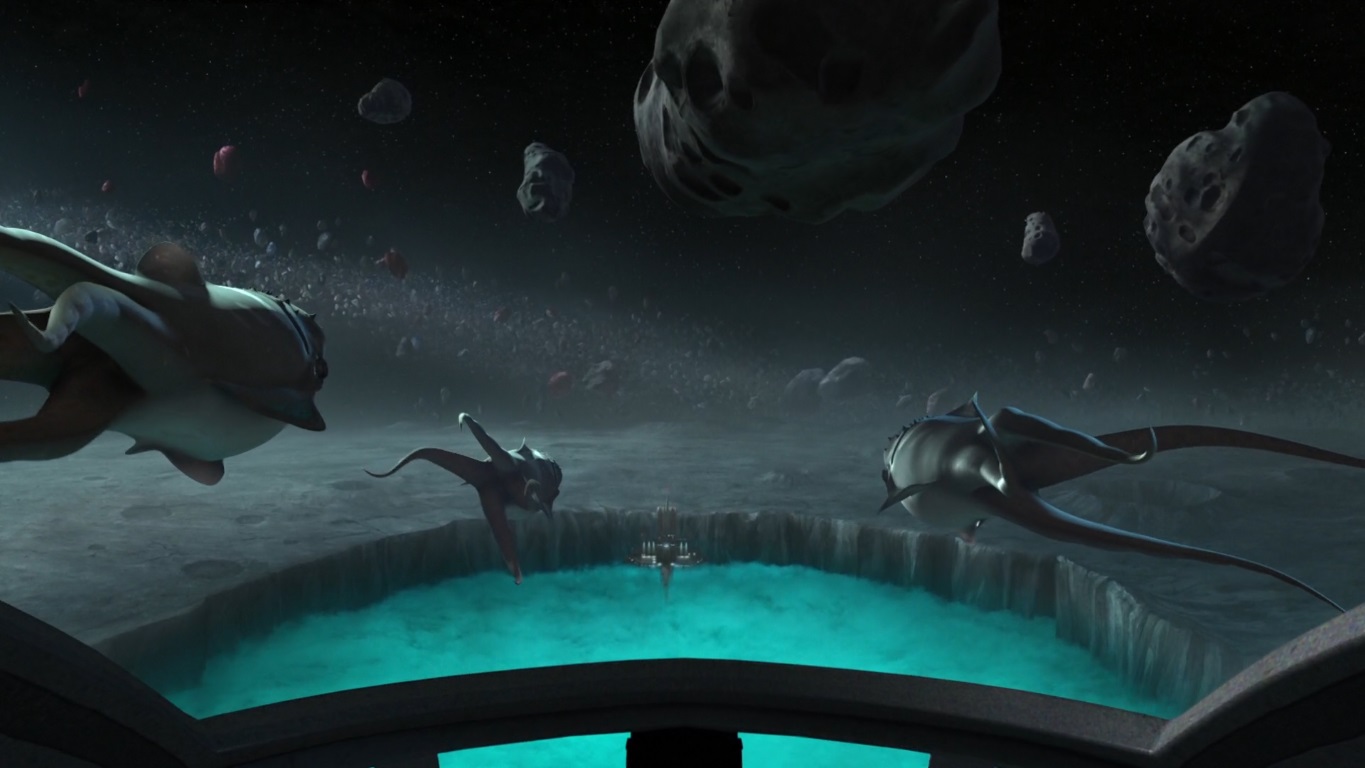
- The fuel which powers the engines is the same as the main power systems, meaning the engine run on energy from the main reactor and
not by burning some kind of 'engine fuel' in a separate reactor. This means that when fuel runs very low, ships must sacrifice other
primary systems to keep the engines running. Gravity and air purification systems in SW can run for a very long time without main
power, since their emitters and processors run on tiny amounts of power and have self-contained power sources or batteries which
recharge when the reactor is running. We know this because of a number of examples of ships which are powered down but which
still have both gravity and breathable air on board. Heating, on the other hand, is one of the more power intensive systems on a ship
and will barely function without the main reactor, if at all. Obtaining fuel is the primary limiting factor in galactic travel.
- Clouzon-36 is a rare but naturally-occurring gas which is useful as reactor fuel, as well as being a food source for large, spacefaring creatures.
One shipment of clouzon-36 could fuel the Ghost and "all the ships in Phoenix Squadron for a full cycle." A cycle is either similar to
a week or a month. Unrefined clouzon-36 is highly explosive in its pure form.
- The asteroid field scrambles the Ghost's sensors, which is not surprising since nearly everything scrambles, interferes with, or fully
blocks sensors in SW. They are easily confused by complex readings, including sometimes by simple, solid objects like asteroids.
Main Article: Scanners, Sensors, and Cloaking Devices
- Purrgils are a kind of large, spacefaring lifeform with whale-like and squid-like characteristics, which feed on energy-rich gas found in or
near starsystems. They are able to travel at significant speeds due to an energy-based motility method which is the organic equivalent
of ion engines or something similar. They are the only known lifeform to have organic hyperspace capabilities, as they are capable of
generating the necessary energy to enter into hyperspace, allowing them to travel from system to system. The purrgil are usually
considered dangerous by starpilots, as they sometimes wander into hyperspace lanes and crash into ships. This is a common enough
occurrence that Hera has "lost more than one friend that way" and she is only 26, although those multiple friends may have been on
the same ship. Creatures in deep space are so rare that they are not widely-known about by planet-bound types. When Hera was
young, she "was told amazing stories of creatures that lived in the stars, traveled between the worlds. Old pilots said it was"
the purrgil who inspired us to jump from system to system." Hera finds this unbelievable, however it shows that the knowledge
about their abilities which the crew learns here is held by others, at the very least as an old legend. This mytho-historical account
could be accurate in its suggestion that accessing hyperspace was first discovered many thousands of years ago by studying purrgil.
Main Article: Hyperspace Travel
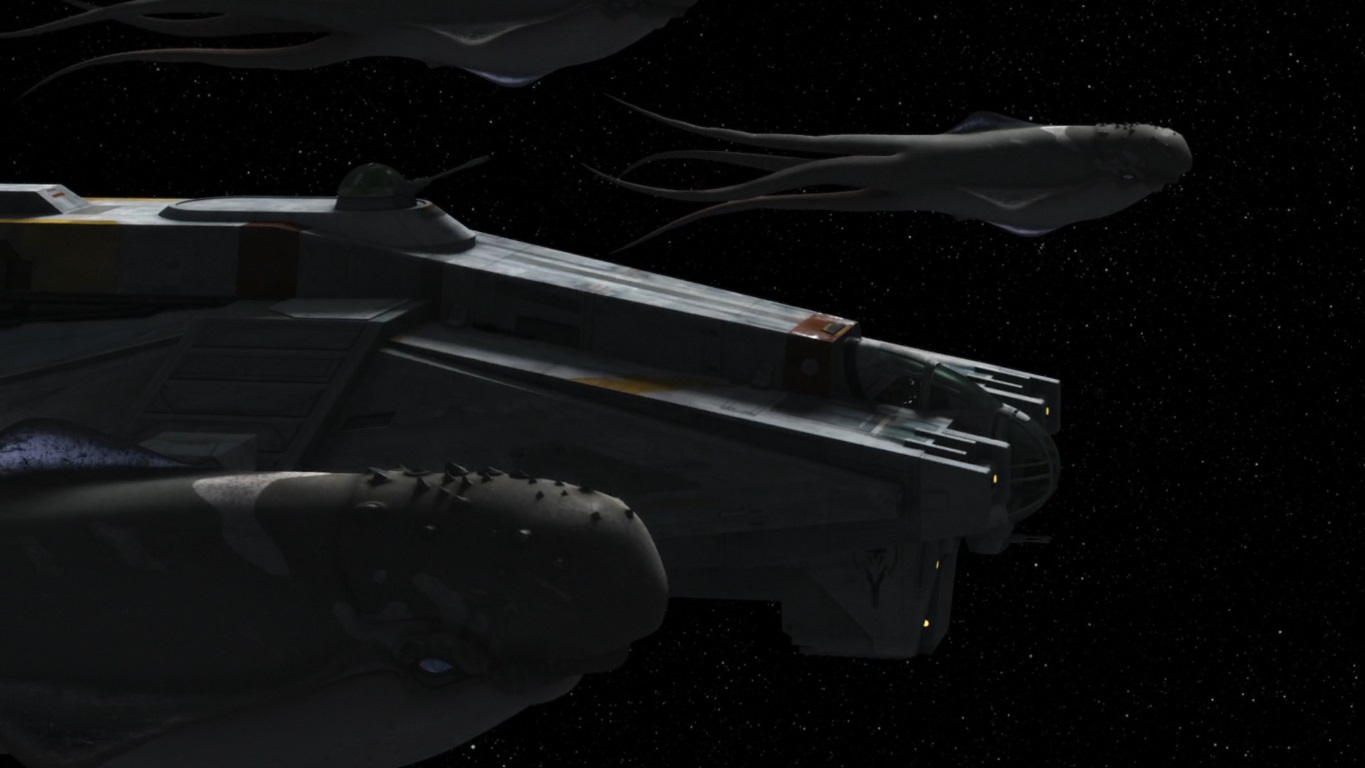
- The TIE/mg starfighters used by the Mining Guild are a product of Sienar Systems like the other TIE series fighters. They are a modification
of the standard TIE/ln design, with two energy collector panels absent from each of their wing stabilizers. This gives this pilot a greater
field of vision, however it apparently means the fighters are less-powerful in combat and are less maneuverable for some reason, at
least according to supplementary material. This may be required by the Empire for Sienar selling fighters to non-military entities.
- Ezra's strong connection to animals and his natural ability to interact with them through the Force has only increased as Ezra grows more
powerful in the Force. In this case, his understanding of the highly intelligent purrgil leads to an alliance between them and the Jedi
which will prove important at the end of this series. Fostering an alliance with nature is a Jedi imperative, and Ezra's abilities have
clearly grown, but at the time he still can get distracted enough not to be able to concentrate on basic Force applications.

Why does the TIE pilot fly close enough to Ezra, who is holding a lightsaber, for Ezra to slash his ship? It could be that he
is not very good, as he is a Mining Guild fighter pilot, and assumed incorrectly that his attack would be successful and
there would be no need to avoid getting near the guy with a laser weapon riding a space whale. In this instance it might
explain this, however the tendency for people and craft to get themselves into range of a Jedi's saber when there is no
need and they have blasters is all too common in SW material, and is the result of lazy and unrealistic storytelling.
ANALYSIS
Some starsystems enjoy a measure of independence and sovereignty under the Empire, if they are sufficiently useful allies to the Empire.
This is not usually the case with worlds the Empire considers valuable or important enough to directly administer, and is much more
common in the Rim regions. Space is vast, and the Empire is happy to save effort and expense to rule over small or unimportant regions
and planets if those in charge of them share enough of the Empire's values. Planets ruled by crime syndicates and dictators are close
enough approximation to Imperial rule for the Empire to ignore. In the case of Concord Dawn, despite having "grabbed up just about
every other place" in the region the Empire has not yet made it an Imperial territory. In this case, it is because the Protectors are acting
like a military garrison and watchpost for the Empire for a mere fraction of the cost of an Imperial presence in this system. Large military
forces outside of the Imperial command structure are not allowed, however skilled warriors like the Protectors who are not so numerous
as to pose a serious threat to the Empire, are very valuable as mercenaries. Fenn Rau doesn't like to think of it that way, as he feels he acts
in the name of the Empire to preserve some measure of dignity and sovereignty for his proud forces and proud people. Taking Rau as
a hostage ensures the Protectors will allow Rebel ships to pass through their system, as they will not want the Empire to discover this or
find out Rau been taken prisoner. If they discover that fact, the Empire will move to take direct control of Concord Dawn.
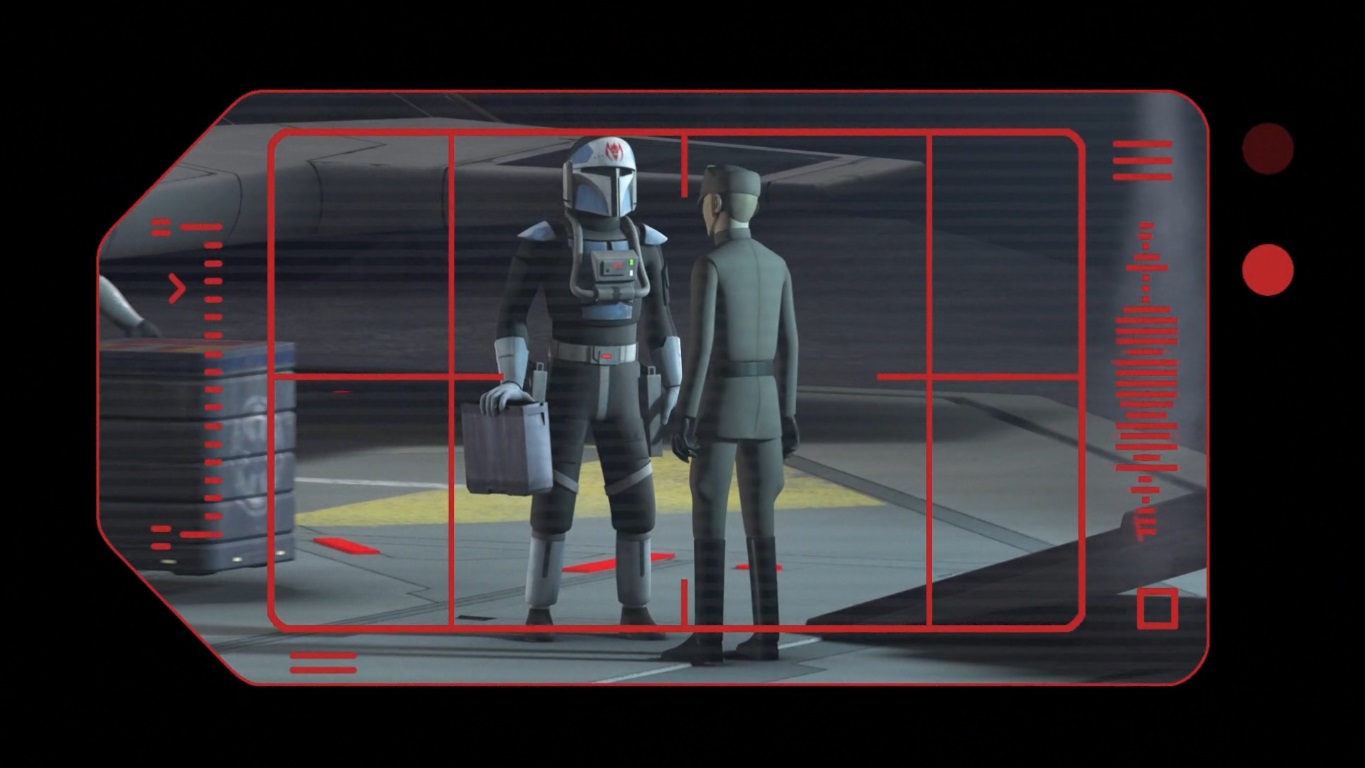
Kanan wants to offer the Protectors a chance to change rather than confront them adversarially, saying, "everyone deserves a chance."
The Jedi are first and foremost diplomats and arbitrators, who in this way try to be peacemakers in keeping with their ethical values and
spiritual priorities. Civilized discussion, which is at the heart of both civil society and actual democracy, is how all problems and conflicts
should be resolved, according to Jedi principles. The Jedi religion values redemption, understanding, and diplomacy, and stands opposed
to conflict and dealing in absolutes. As Mandalorian religion values conflict, Sabine suggests that Jedi philosophy "doesn't work for everyone",
which in Kanan's analysis is "why we're at war." Indeed, just as Sidious predicted during his move against the Jedi at the fall of the Republic,
the Jedi would never accept a non-democratic galactic state which doesn't meet their minimum ethical standards. They will fight against
such an order, and thus are not a pacifist philosophy. Conflict and competition based philosophies produce endless conflict, discord, and
suffering when they wield power in society. The Jedi way is more natural, but requires a majority consensus to hold the similar ideals.
The Jedi do not require people to have their beliefs due to their belief in personal liberty, and therefore they must serve as knights, and
constantly fight those who wish to instigate conflict and exploitation: criminals, slavers, oppressive states, and agents of the dark side.

Many Lasats practice a post-technological religion centered around writings and practices which formed after their race had star travel.
The Lasats on Lasan not only forgot about their original homeworld to the point is was relegated to myth, but overtime that historical
memory was more widely known as a prophecy about the future. Lira San was prophesized in the ancient Lasat writings as the "new
world" which is the future destiny of their people, which in spiritual terms is Lasan reborn. This is much the same way as the Garden
in biblical texts and related theology, which regards it as the past state of mankind as well as its future destined paradise, which itself
is a 'new Earth'. The Lasat writings were inspired by the Force, and Force attuned crystals are used in the ritual practices of this religion
for very practical purposes. The Lasat spiritual leaders have faith in the Force, or Ashla as they call it, despite the fact that their sacred
writings are more metaphorical than historical, their prophecy is only understandable after it has been fulfilled, and their beliefs turn
out to have been at least partly misinformed. Their faith is rewarded since the prophecy was true, events were guided by a higher
power towards the fulfillment of that prophecy, and Lira San proved to be more than they could have hoped for, despite it not being
what they expected. This was achieved through spiritual belief, as the Lasats' faith preserved them and made them strive to reach
Lira San, technology and materials, as energized crystals which channel the Force were needed to unlock the route to Lira San,
as well as a higher power, as the Force ultimately provided the hyperspace coordinates and guided their ship safely to the planet.
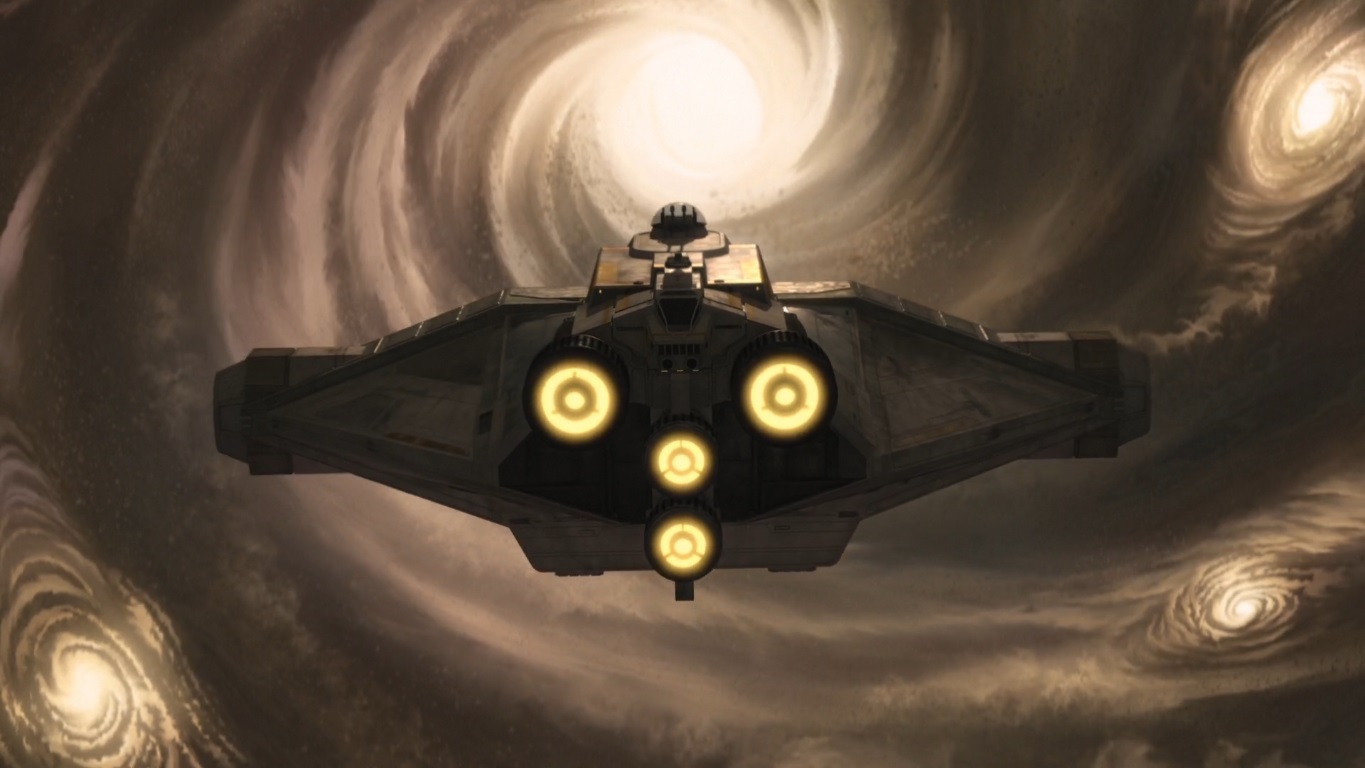
Industrial mining is responsible for providing the raw materials needed for the gargantuan construction activity taking place at any time across
known space, as well as device and starship manufacturing, fuel supplies, and a huge variety of other industries. These efforts are monitored
and governed by an organization known as the Mining Guild, which at this point in galactic history was an ancient institution. As with any guild,
membership was required within the industry for operations of any significance, but was also considered a desirable arrangement for the many
protections and privileges it affords. The Guild inevitably became more centrally-controlled over the millennia, however after the coming of
the Empire this would be accelerated as the Guild became increasingly integrated into the Imperial state, perhaps to the point of nationalization.
At this point in history, after a decade and a half of Imperial rule, the Mining Guild is essentially a semi-autonomous agency within the Imperial
structure, an even that small measure of independence is contingent on its full cooperation with the state. The Guild is seen in these events
mining and refining clouzon-36 gas as fuel for the Empire, suggesting that some if not most of its mining efforts are centrally directed by
Imperial authorities as part of their fascist economy. The priorities of Guild leaders at this time are completely compatible with Imperial goals
and methods, as they are concerned only with profit and resources, have little regard for nature, and readily use force to solve problems.
It is unlikely they were much different under the Republic, however that society was sometimes less tolerant of overt callousness.
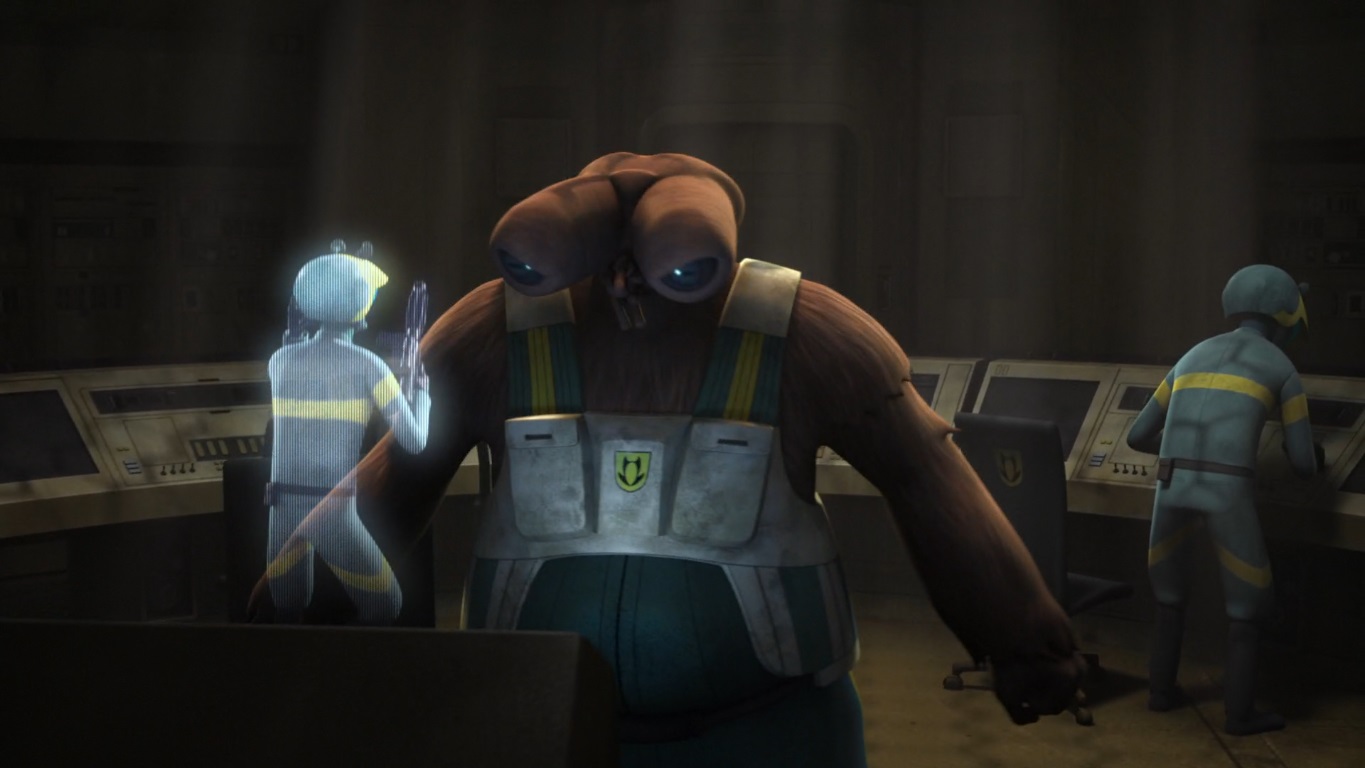
FURTHER ANALYSIS
The Scars of Concord Dawn - A Physicist Overthinks Star Wars Rebels